4.7: Calculating Centers of Mass and Moments of Inertia
( \newcommand{\kernel}{\mathrm{null}\,}\)
Learning Objectives
- Use double integrals to locate the center of mass of a two-dimensional object.
- Use double integrals to find the moment of inertia of a two-dimensional object.
- Use triple integrals to locate the center of mass of a three-dimensional object.
We have already discussed a few applications of multiple integrals, such as finding areas, volumes, and the average value of a function over a bounded region. In this section we develop computational techniques for finding the center of mass and moments of inertia of several types of physical objects, using double integrals for a lamina (flat plate) and triple integrals for a three-dimensional object with variable density. The density is usually considered to be a constant number when the lamina or the object is homogeneous; that is, the object has uniform density.
Center of Mass in Two Dimensions
The center of mass is also known as the center of gravity if the object is in a uniform gravitational field. If the object has uniform density, the center of mass is the geometric center of the object, which is called the centroid. Figure
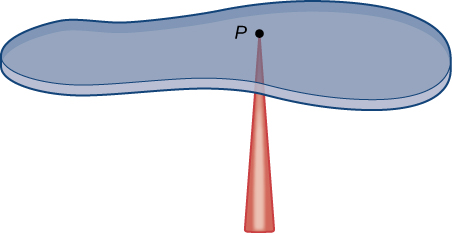
To find the coordinates of the center of mass
and
Refer to Moments and Centers of Mass for the definitions and the methods of single integration to find the center of mass of a one-dimensional object (for example, a thin rod). We are going to use a similar idea here except that the object is a two-dimensional lamina and we use a double integral.
If we allow a constant density function, then
Suppose that the lamina occupies a region
where
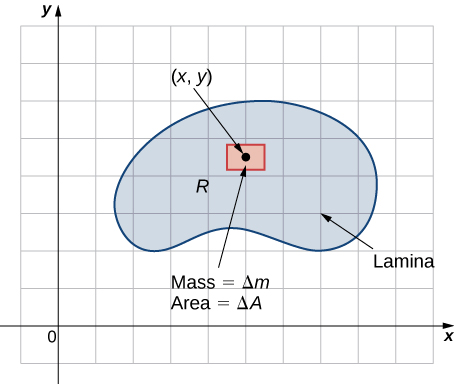
Just as before, we divide the region
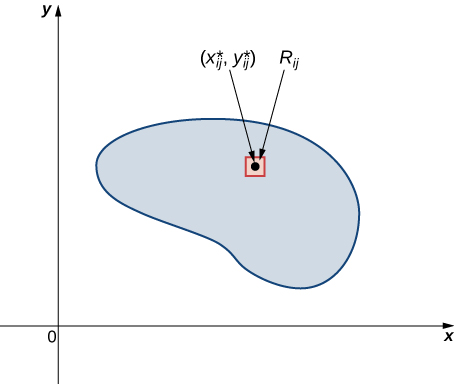
Hence, the mass of the lamina is
Let’s see an example now of finding the total mass of a triangular lamina.
Example
Consider a triangular lamina
Solution
A sketch of the region
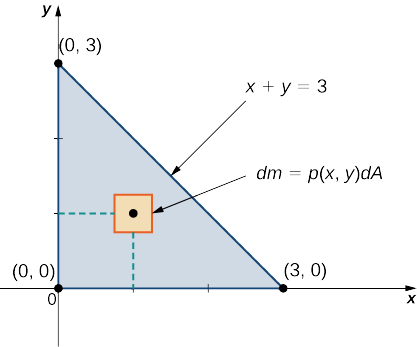
Using the expression developed for mass, we see that
The computation is straightforward, giving the answer
Exercise
Consider the same region
- Answer
-
Now that we have established the expression for mass, we have the tools we need for calculating moments and centers of mass. The moment
Similarly, the moment
Example
Consider the same triangular lamina
Solution
Use double integrals for each moment and compute their values:
The computation is quite straightforward.
Exercise
Consider the same lamina
- Answer
-
Finally we are ready to restate the expressions for the center of mass in terms of integrals. We denote the x-coordinate of the center of mass by
and
Example
Again consider the same triangular region
Solution
Using the formulas we developed, we have
Therefore, the center of mass is the point
If we choose the density
Notice that the center of mass
Exercise
Again use the same region
- Answer
-
Once again, based on the comments at the end of Example
We should use these formulas and verify the centroid of the triangular region R referred to in the last three examples.
Example
Find the mass, moments, and the center of mass of the lamina of density
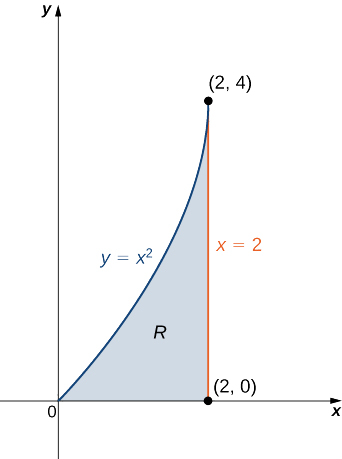
Solution
First we compute the mass
Now compute the moments
Finally, evaluate the center of mass,
Hence the center of mass is
Exercise
Calculate the mass, moments, and the center of mass of the region between the curves
- Answer
-
Example
Find the centroid of the region under the curve

Solution
To compute the centroid, we assume that the density function is constant and hence it cancels out:
Thus the centroid of the region is
Exercise
Calculate the centroid of the region between the curves
- Answer
-
Moments of Inertia
For a clear understanding of how to calculate moments of inertia using double integrals, we need to go back to the general definition in Section
The moment of inertia
Similarly, the moment of inertia
Sometimes, we need to find the moment of inertia of an object about the origin, which is known as the polar moment of inertia. We denote this by
All these expressions can be written in polar coordinates by substituting
Example
Use the triangular region
Solution
Using the expressions established above for the moments of inertia, we have
Exercise
Again use the same region
- Answer
-
As mentioned earlier, the moment of inertia of a particle of mass
Hence the radii of gyration with respect to the
respectively. In each case, the radius of gyration tells us how far (perpendicular distance) from the axis of rotation the entire mass of an object might be concentrated. The moments of an object are useful for finding information on the balance and torque of the object about an axis, but radii of gyration are used to describe the distribution of mass around its centroidal axis. There are many applications in engineering and physics. Sometimes it is necessary to find the radius of gyration, as in the next example.
Example
Consider the same triangular lamina
Solution
If we compute the mass of this region we find that
Exercise
Use the same region
- Hint
-
Follow the steps shown in the previous example.
- Answer
-
Example
Suppose
Solution
We have used this tetrahedron before and know the limits of integration, so we can proceed to the computations right away. First, we need to find the moments about the
Hence the center of mass is
The center of mass for the tetrahedron
Exercise
Consider the same region
- Hint
-
Check that
- Answer
-
We conclude this section with an example of finding moments of inertia
Example
Suppose that
Solution
Once again, we can almost immediately write the limits of integration and hence we can quickly proceed to evaluating the moments of inertia. Using the formula stated before, the moments of inertia of the tetrahedron
Proceeding with the computations, we have
Thus, the moments of inertia of the tetrahedron
Exercise
Consider the same region
- Answer
-
The moments of inertia of the tetrahedron
Key Concepts
Finding the mass, center of mass, moments, and moments of inertia in double integrals:
- For a lamina
- The moments about the
- The center of mass is given by
- The center of mass becomes the centroid of the plane when the density is constant.
- The moments of inertia about the
Finding the mass, center of mass, moments, and moments of inertia in triple integrals:
- For a solid object
- The moments about the
- The center of mass is given by
- The center of mass becomes the centroid of the solid when the density is constant.
- The moments of inertia about the
Key Equations
- Mass of a lamina
- Moment about the x-axis
- Moment about the y-axis
- Center of mass of a lamina
Glossary
- radius of gyration
- the distance from an object’s center of mass to its axis of rotation
Contributors
Gilbert Strang (MIT) and Edwin “Jed” Herman (Harvey Mudd) with many contributing authors. This content by OpenStax is licensed with a CC-BY-SA-NC 4.0 license. Download for free at http://cnx.org.



Center of Mass and Moments of Inertia in Three Dimensions
All the expressions of double integrals discussed so far can be modified to become triple integrals.
Definition
If we have a solid object
Its moments about the
If the center of mass of the object is the point
Also, if the solid object is homogeneous (with constant density), then the center of mass becomes the centroid of the solid. Finally, the moments of inertia about the
Example
Suppose that
Solution
The region
Exercise
Consider the same region
Follow the steps in the previous example.